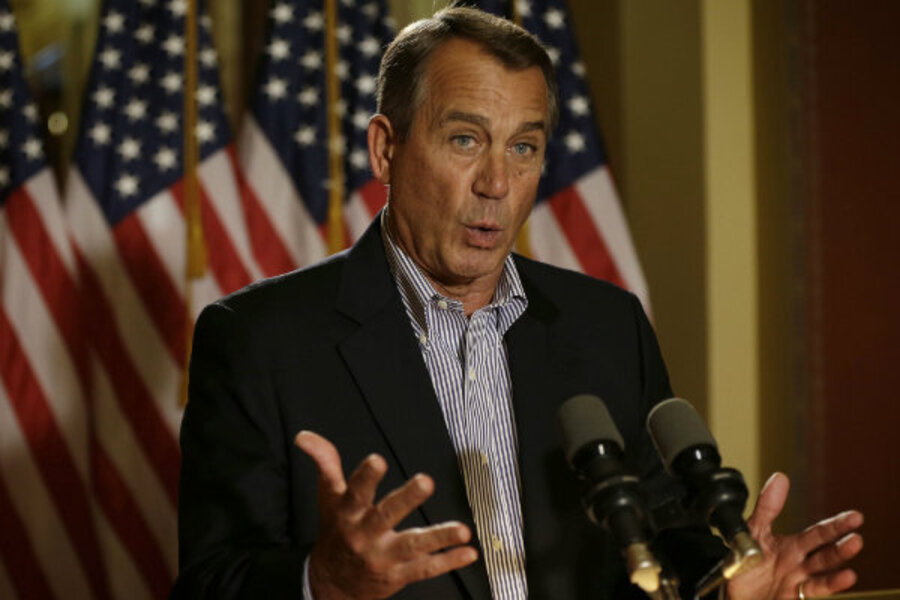'Fiscal cliff' or not, tax reform is easier said than done
Loading...
| Claremont, Calif.
As part of any “fiscal cliff” bargain, Congress will probably take up comprehensive tax reform next year. At first, its benefits seem almost magical. Just scrap the loopholes that benefit special interests, and – presto! – we can ease burdens on the middle class, toss out tons of paperwork, and raise revenue for the government.
Alas, Congress isn’t Hogwarts, and tax legislation isn’t sorcery. Reform is a worthy goal, but it will involve more political and economic pain than lawmakers would like to admit.
A misunderstanding tends to warp discussions of the federal tax code. Because of billionaire Warren Buffett’s claim that he pays a lower tax rate than his secretary, many people think that the rich pay little tax and that working people carry the lion’s share of the load. Wrong.
According to the nonpartisan Congressional Budget Office, the top one-fifth of households contributed about two-thirds of total federal taxes in 2009, the latest year for which data are available. This group paid an effective rate of 23.2 percent, while lower-income groups paid progressively lower rates, down to just one percent for the bottom one-fifth.
Some argue that, as a matter of fairness, we should make the affluent pay an even higher rate than they already do. Fine, but we can’t squeeze them for enough additional revenue to balance the budget.
That’s where “loopholes” come in. By ending a number of deductions or credits, Congress would enable the government to collect more money, at least in principle. There’s just one problem: Every line in the tax code has its own constituency and rationale.
For example, the mortgage-interest deduction costs the Treasury more than $80 billion a year, but it has succeeded at fostering home ownership, and few politicians would dare to cross all the millions of taxpayers who use it. Congress could limit the political risk by reducing the deduction only for top earners. Yet even that modest step could hurt the housing market, incurring the wrath not only of the affected taxpayers, but also realtors and construction workers.
Likewise, curbing the deduction for charitable contributions would be a blow to churches and other nonprofits. Go down the list of “loopholes,” and you will see a comparable story every time.
Despite such obstacles, Congress did pass a 1986 law that eliminated numerous tax shelters while lowering rates and simplifying the tax code. That measure proved that reform is possible, but its enactment hinged on circumstances that are hard to repeat.
The first was an intellectual consensus that bridged ideological lines: Supporters of reform ranged from Rep. Jack Kemp (R) of New York on the right to Sen. Bill Bradley (D) of New Jersey on the left. They agreed that the tax code rewarded individuals and businesses for gaming the system rather than contributing to economic growth and job creation.
Moreover, key leaders had unusually strong motives to move the bill. President Reagan had believed in tax reform ever since paying exorbitant rates at the peak of his movie career. Dan Rostenkowski (D) of Illinois, chairman of the tax-writing House Ways and Means Committee, wanted to prove that he was a statesman, not just a Chicago hack. Bob Packwood (R) of Oregon, chairman of the Senate Finance Committee, initially undercut the reform effort but turned around after enduring brutal criticism from the press.
The bill had a wild ride through Capitol Hill. At one point, House Republicans almost derailed it through a procedural maneuver, and it took personal lobbying by President Reagan to put it back on track. The bill’s supporters were lucky that its opponents never got together.
Treasury official Richard Darman told reporters Jeffrey H. Birnbaum and Alan S. Murray, “[I]f I were a lobbyist, I would stand in the hallway with a big sign saying: EVERYONE INTERESTED IN KILLING THIS BILL, PLEASE MEET IN THE NEXT CORRIDOR. There would have been an enormous rush, and they would have seen the power of their collective action.”
Conditions for passage are less favorable today. Lobbyists have become adept at collective action to beat legislation, while political polarization has made it harder for Republicans and Democrats to join in passing anything at all.
Why do so many lawmakers think that they can enact a tax reform bill in 2013? One reason is that so few of them experienced how arduous the last one was. Of 435 lawmakers who will sit in the House next year, only 21 were serving in 1986. Those 21 do not include Speaker John Boehner, Minority Leader Nancy Pelosi, or any GOP member of the Ways and Means Committee.
The 100-member Senate will have a somewhat larger fraction of 1986 veterans: 11 who were in the Senate at the time, 10 who were in the House. Majority leader Harry Reid and Minority leader Mitch McConnell were on Capitol Hill in 1986, but did not play major roles in the tax drama.
Lawmakers who back tax reform should speak with those who went through the 1986 debate. They should also study histories of the legislation, including the excellent book, “Showdown at Gucci Gulch,” by Mr. Birnbaum and Mr. Murray. Then they should fasten their seatbelts. It’s going to be a bumpy year.
John J. Pitney Jr. is the Roy P. Crocker professor of American politics at Claremont McKenna College. He is coauthor of “American Government and Politics: Deliberation, Democracy, and Citizenship.”





